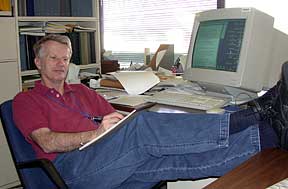About Working at NSSL...

The National Severe Storms Laboratory is composed of Meteorologists, both at the Masters and Ph.D. level, Physicists, Electrical Engineers, and Computer Scientists. Most of the staff are Meteorologists with degrees from all over the world. In addition to NSSL staff, scientific staff from NSSL's university partner, the University of Oklahoma, also conduct joint research at NSSL.
The types of meteorology we study are storm-scale and mesoscale meteorology (that is, thunderstorms and complexes of thunderstorms), storm-environment (what type of conditions prepare the atmosphere for storms to develop), numerical modeling, and any other type of hazardous weather including winter weather. When hiring we look for people who have been through quality degree programs and have experience with this type of meteorology. Other opportunities may be for physicists who study storm electricity or lightning, electrical engineers with experience with radar technology, and computer scientists to help support the science in the lab.
NSSL carries out a mix of basic research in areas of storm initiation and development and tornado development, applied research involving software development for Doppler radar (NEXRAD, etc.), and data collection.
Our studies of severe weather phenomenon often require us to collect data not otherwise available. We are known for our storm chasing or storm intercept experiments, such as VORTEX, that took place in the Great Plains region of the U.S. Photogrammetric and meteorological data from severe storms and tornadoes have helped us come closer to understanding how tornadoes form and dissipate. We have also performed data collection experiments in areas such as the intermountain west to improve the understanding, analysis, and prediction of precipitation and precipitation processes in complex terrain; the Gulf of Mexico to determine how Gulf moisture surges into the southern plains to fuel storms; in Arizona to study and better understand the southwest monsoon season, what causes the storms to form and how to improve storm forecasts; and in Western Oklahoma and the Texas Panhandle to study drylines. These projects are led by Ph.D. scientists who carefully pose the challenges being addressed in order to design feasible projects, lead brief collection efforts, and spend years analyzing the results. Other staff for these projects may come from collaborators at universities and labs around the world, as well as our own staff from other projects within NSSL, and sometimes meteorology majors from U.S. colleges and universities. We do not hire storm chasers.
NSSL often provides funding for collaborative research
projects to the Cooperative
Institute for Mesoscale Meteorological Studies ![]() (CIMMS),
a joint institute formed between NOAA and the University of Oklahoma
(OU). For the duration of these research projects, CIMMS employees are
located at NSSL. You may check the OU Job Hotline for current positions
by calling 405-325-4343 or visiting the OU
jobs web site.
(CIMMS),
a joint institute formed between NOAA and the University of Oklahoma
(OU). For the duration of these research projects, CIMMS employees are
located at NSSL. You may check the OU Job Hotline for current positions
by calling 405-325-4343 or visiting the OU
jobs web site.![]() You
can also check the broader job links listed in Meteorology
Careers.
You
can also check the broader job links listed in Meteorology
Careers.
OU/CIMMS employees enjoy the excellent benefits provided by the University of Oklahoma while working at the NSSL. CIMMS and the University of Oklahoma are equal opportunity employers.
If you would like to send your resume for future reference, please mail it to:
Attn: Linda Skaggs
National Severe Storms Laboratory
120 David L Boren Blvd
Norman, OK 73072
